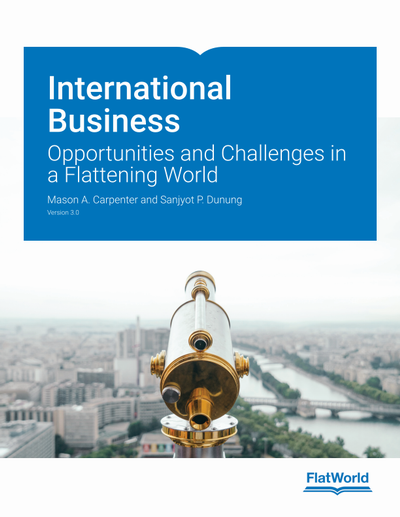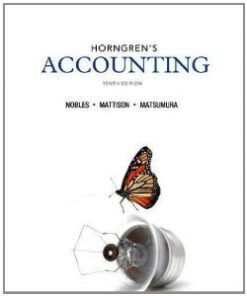Solution Manual for International Business: Opportunities and Challenges in a Flattening World, Version: 3.0, By: Mason A. Carpenter, Sanjyot P. Dunung, ISBN: 9781453386842
$55.00
Solution Manual for International Business: Opportunities and Challenges in a Flattening World, Version: 3.0, By: Mason A. Carpenter, Sanjyot P. Dunung, ISBN: 9781453386842
Solution Manual for International Business: Opportunities and Challenges in a Flattening World, Version: 3.0, By: Mason A. Carpenter, Sanjyot P. Dunung, ISBN: 9781453386842
This is not an original TEXT BOOK (or Test Bank or original eBook). You are buying Solution Manual. A Solution Manual is step by step solutions of end of chapter questions in the text book. Solution manual offers the complete detailed answers to every question in textbook at the end of chapter. Please download sample for your confidential. All orders are safe, secure and confidential.
Chapter 1: Introduction
1.1 What Is International Business?
1.2 Who Is Interested In International Business?
1.3 What Forms Do International Businesses Take?
1.4 The Globalization Debate
1.5 Ethics And International Business
1.6 End Of Chapter Questions And Exercises
Chapter 2: International Trade and Foreign Direct Investment
2.1 What Is International Trade Theory?
2.2 Political And Legal Factors That Impact International Trade
2.3 Foreign Direct Investment
2.4 Tips In Your Entrepreneurial Toolkit
2.5 End Of Chapter Questions And Exercises
Chapter 3: Culture and Business
3.1 What Is Culture, Anyhow? Values, Customs, And Language
3.2 What Are The Key Methods Used To Describe Cultures?
3.3 Understanding How Culture Impacts Local Business Practices
3.4 Global Business Ethics
3.5 Tips In Your Entrepreneurial Toolkit
3.6 End Of Chapter Questions And Exercises
3.7 Additional References
Chapter 4: World Economies
4.1 Classifying World Economies
4.2 Understanding The Developed World
4.3 Developing World
4.4 Emerging Markets
4.5 Tips In Your Entrepreneurial Toolkit
4.6 End Of Chapter Questions And Exercises
Chapter 5: Global and Regional Economic Cooperation and Integration
5.1 International Economic Cooperation Among Nations
5.2 Regional Economic Integration
5.3 The United Nations And The Impact On Trade
5.4 End Of Chapter Questions And Exercises
Chapter 6: International Monetary System
6.1 What Is The International Monetary System?
6.2 What Is The Role Of The Imf And The World Bank?
6.3 Understanding How International Monetary Policy, The Imf, And The World Bank Impact Business Practices
6.4 Tips In Your Entrepreneurial Toolkit
6.5 End Of Chapter Questions And Exercises
Chapter 7: Foreign Exchange and the Global Capital Markets
7.1 What Do We Mean By Currency And Foreign Exchange?
7.2 Understanding International Capital Markets
7.3 Venture Capital And The Global Capital Markets
7.4 Tips In Your Entrepreneurial Toolkit
7.5 End Of Chapter Questions And Exercises
Chapter 8: International Expansion and Global Market Opportunity Assessment
8.1 Global Strategic Choices
8.2 Pestel, Globalization, And Importing
8.3 International Expansion Entry Modes
8.4 Cage Analysis
8.5 Scenario Planning And Analysis
8.6 End Of Chapter Questions And Exercises
Chapter 9: Exporting, Importing, and Global Sourcing
9.1 What Are Importing And Exporting?
9.2 Countertrade
9.3 Global Sourcing And Its Role In Business
9.4 Managing Export And Import
9.5 What Options Do Companies Have For Export And Import Financing?
9.6 Tips In Your Entrepreneurial Toolkit
9.7 End Of Chapter Questions And Exercises
Chapter 10: Strategy and International Business
10.1 Business And Corporate Strategy
10.2 Generic Strategies
10.3 International Strategy
10.4 The Five Elements Of Strategy
10.5 Managing The International Business With The P O L C Framework
10.6 End Of Chapter Questions And Exercises
Chapter 11: Global Entrepreneurship and Intrapreneurship
11.1 Entrepreneurship
11.2 What Do Entrepreneurs Do?
11.3 Business Entrepreneurship Across Borders
11.4 From Entrepreneurship To Born Global Firms
11.5 From Entrepreneurship To Intrapreneurship
11.6 End Of Chapter Questions And Exercises
Chapter 12: Winning through Effective, Global Talent Management
12.1 The Changing Role Of Strategic Human Resources Management In International Business
12.2 The Global War For Talent
12.3 Effective Selection And Placement Strategies
12.4 The Roles Of Pay Structure And Pay For Performance
12.5 Tying It All Together—Using The Hrm Balanced Scorecard To Gauge And Manage Human Capital, Including Your Own
12.6 Tips In Your Entrepreneurial Toolkit
12.7 End Of Chapter Questions And Exercises
Chapter 13: Harnessing the Engine of Global Innovation
13.1 An Introduction To Research And Development (R&D)
13.2 Intellectual Property Rights Around The Globe
13.3 How To Organize And Where To Locate Research And Development Activities
13.4 Increasing Speed And Effectiveness Of International Innovation
13.5 Innovation For The Bottom Of The Pyramid
13.6 End Of Chapter Questions And Exercises
Chapter 14: Competing Effectively through Global Marketing, Distribution, and Supply-Chain Management
14.1 Fundamentals Of Global Marketing
14.2 Critical Decision Points In Global Marketing
14.3 Standardized Or Customized Products
14.4 Global Sourcing And Distribution
14.5 Global Production And Supply Chain Management
14.6 End Of Chapter Questions And Exercises
Chapter 15: Understanding the Roles of Finance and Accounting in Global Competitive Advantage
15.1 International Accounting Standards
15.2 Accounting In International Business
15.3 Fundamentals Of Finance
15.4 Financial Management In International Business
15.5 Global Money Management: Moving Money Across Borders
15.6 End Of Chapter Questions And Exercises
Be the first to review “Solution Manual for International Business: Opportunities and Challenges in a Flattening World, Version: 3.0, By: Mason A. Carpenter, Sanjyot P. Dunung, ISBN: 9781453386842” Cancel reply
Related products
Solution Manual
Solution Manual for Introduction to Electrodynamics, 4/E 4th
Solution Manual
Solution Manual for Psychology and Life 20th Edition by Gerrig












Reviews
There are no reviews yet.